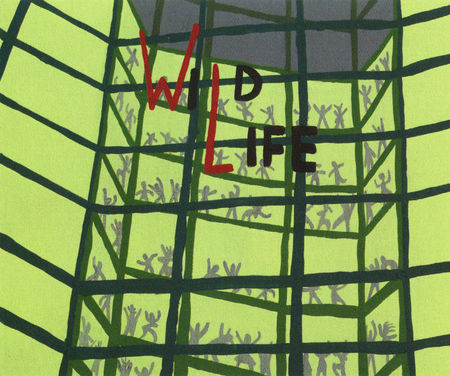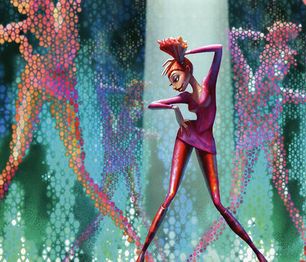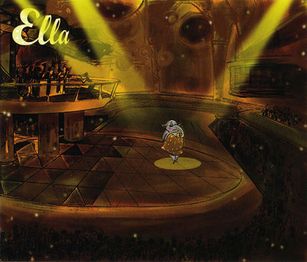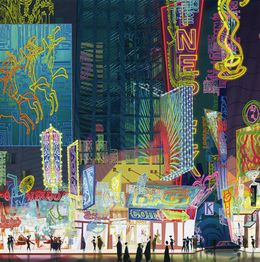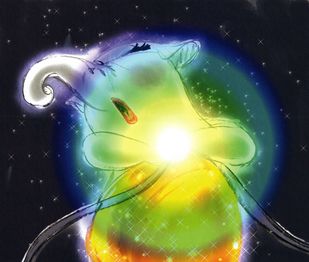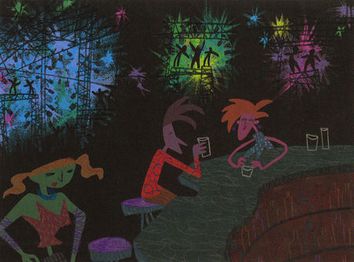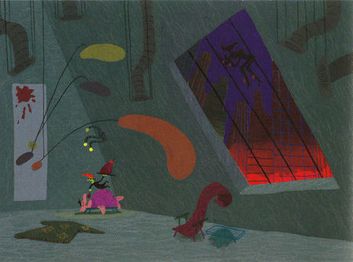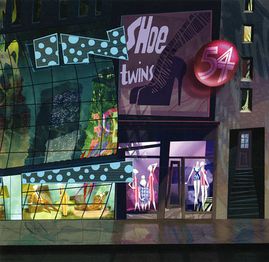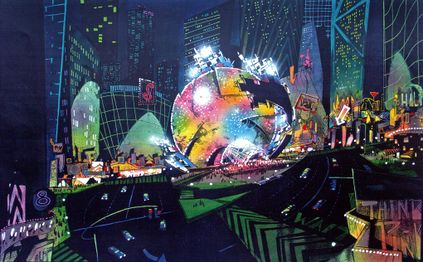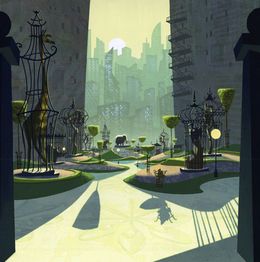Wild Life (lost production material for cancelled Disney animated film; late 1990s-2000): Difference between revisions
mNo edit summary |
Happy Brian (talk | contribs) (Wild Life: The Plagiarism-Free Edition has arrived!) |
||
| Line 5: | Line 5: | ||
|status=<span style="color:red;">'''Lost'''</span> | |status=<span style="color:red;">'''Lost'''</span> | ||
}} | }} | ||
'''''Wild Life''''' is a cancelled late 1999-2000 CGI-animated film directed by Howard Baker and Roger Gould. | '''''Wild Life''''' (not to be confused with the similarly named 2016 computer animated film '''The Wild Life''') is a cancelled late 1999-2000 CGI-animated film directed by Howard Baker and Roger Gould and was to be animated by Disney's then-current special effects team The Secret Lab. | ||
The movie would have been reminiscent of 1970s American pop culture and would have paid homage to popular figures at the time such as Andy Warhol, Anna Wintour | The movie would have been reminiscent of 1970s American pop culture and would have paid homage to popular figures at the time such as Andy Warhol, Anna Wintour and Diana Vreeland.<ref>[http://disney.wikia.com/wiki/Wild_Life Disney Wiki's page on the film] Retrieved October 3, 2017</ref> | ||
==Plot== | ==Plot== | ||
The plot | The film's plot was loosely based on George Bernard Shaw's 1913 play ''Pygmalion''<ref>[http://en.wikifur.com/wiki/Wild_Life_(movie) Wikifur's entry on the film] Retrieved October 3, 2017</ref>, as it involves Red and Kitty-Glitter trying to find a new star for Club Wild Life as Kitty Glitter, once the star attraction for Club Wild Life, has dwindled in popularity in contrast to Magda, the editor of the popular fashion magazine "Magazizi" and a operator of a popular night club that rivals Red's club. | ||
Red and Kitty-Glitter then find their new star in Ella, a talking elephant they found in the zoo. Ella is reluctant to be a new star for Club Wild Life, but after a an accident on the stage where she is electrocuted by wires, she instantly transforms into a singing diva and becomes rich and famous, much to Red and Kitty's delight. However, Ella soon gets tired of her new lifestyle and wishes to return to the zoo, which eventually causes complications for Red, Kitty and Ella. | |||
==Development== | |||
''Wild Life'' began production in 1999, under a team of animators that included Hans Bacher, Floyd Norman Jim Hill, George Mac, Doug Walker (unrelated to the Nostalgia Critic), Craig Kellman, Buck Lewis and Darryl Kidder, who also served as head of story. | |||
In the words of Jim Hill, the directors were hoping to create something that would really ''knock the socks off the competition.'' They wanted ''Wild Life'' to have a mature edge and wrote some adult-oriented jokes, however, the people working on the movie, especially the animators, often worried that Disney would not want to release the film. This constant fear was realized when Roy Disney, then vice chairman of the board, viewed the presentation reel in fall 1999 and stated that he was "appalled" at the mature humor (particularly one joke where two gay characters are about to enter the sewers and one remarked ''"have you ever been down a manhole before?"'') and ordered the film to be shut down.<ref>[http://jimhillmedia.com/editor_in_chief1/b/jim_hill/archive/2003/01/15/224.aspx Jim Hill's blog post on The Secret Lab, with a brief mention of ''Wild Life''.] Retrieved October 3, 2017</ref> | |||
The Secret Lab had previously produced the 2000 CGI-animated/live action film ''Dinosaur'' with Disney, but after the film was shelved, the company was shut down. | |||
==Availability== | |||
Though concept artwork from the film has been made available through the 2008 book on cancelled Disney animated films titled ''Disney Lost and Found: Exploring the Hidden Artwork from Never-Produced Animation'' by Charles Soloman, no footage of the film has ever been released to the public and no pictures or video of the presentation reel have ever been leaked. | |||
==Image gallery== | ==Image gallery== | ||
| Line 38: | Line 39: | ||
File:WildLifeVisDevelopment (3).jpg|Ella in the zoo by Hans Bacher | File:WildLifeVisDevelopment (3).jpg|Ella in the zoo by Hans Bacher | ||
</gallery> | </gallery> | ||
==References== | |||
<references/> | |||
[[Category:Lost animation]] | [[Category:Lost animation]] | ||
[[Category:Lost films]] | [[Category:Lost films]] | ||
Revision as of 15:50, 3 October 2017
Wild Life (not to be confused with the similarly named 2016 computer animated film The Wild Life) is a cancelled late 1999-2000 CGI-animated film directed by Howard Baker and Roger Gould and was to be animated by Disney's then-current special effects team The Secret Lab.
The movie would have been reminiscent of 1970s American pop culture and would have paid homage to popular figures at the time such as Andy Warhol, Anna Wintour and Diana Vreeland.[1]
Plot
The film's plot was loosely based on George Bernard Shaw's 1913 play Pygmalion[2], as it involves Red and Kitty-Glitter trying to find a new star for Club Wild Life as Kitty Glitter, once the star attraction for Club Wild Life, has dwindled in popularity in contrast to Magda, the editor of the popular fashion magazine "Magazizi" and a operator of a popular night club that rivals Red's club.
Red and Kitty-Glitter then find their new star in Ella, a talking elephant they found in the zoo. Ella is reluctant to be a new star for Club Wild Life, but after a an accident on the stage where she is electrocuted by wires, she instantly transforms into a singing diva and becomes rich and famous, much to Red and Kitty's delight. However, Ella soon gets tired of her new lifestyle and wishes to return to the zoo, which eventually causes complications for Red, Kitty and Ella.
Development
Wild Life began production in 1999, under a team of animators that included Hans Bacher, Floyd Norman Jim Hill, George Mac, Doug Walker (unrelated to the Nostalgia Critic), Craig Kellman, Buck Lewis and Darryl Kidder, who also served as head of story.
In the words of Jim Hill, the directors were hoping to create something that would really knock the socks off the competition. They wanted Wild Life to have a mature edge and wrote some adult-oriented jokes, however, the people working on the movie, especially the animators, often worried that Disney would not want to release the film. This constant fear was realized when Roy Disney, then vice chairman of the board, viewed the presentation reel in fall 1999 and stated that he was "appalled" at the mature humor (particularly one joke where two gay characters are about to enter the sewers and one remarked "have you ever been down a manhole before?") and ordered the film to be shut down.[3]
The Secret Lab had previously produced the 2000 CGI-animated/live action film Dinosaur with Disney, but after the film was shelved, the company was shut down.
Availability
Though concept artwork from the film has been made available through the 2008 book on cancelled Disney animated films titled Disney Lost and Found: Exploring the Hidden Artwork from Never-Produced Animation by Charles Soloman, no footage of the film has ever been released to the public and no pictures or video of the presentation reel have ever been leaked.
Image gallery
References
- ↑ Disney Wiki's page on the film Retrieved October 3, 2017
- ↑ Wikifur's entry on the film Retrieved October 3, 2017
- ↑ Jim Hill's blog post on The Secret Lab, with a brief mention of Wild Life. Retrieved October 3, 2017
